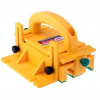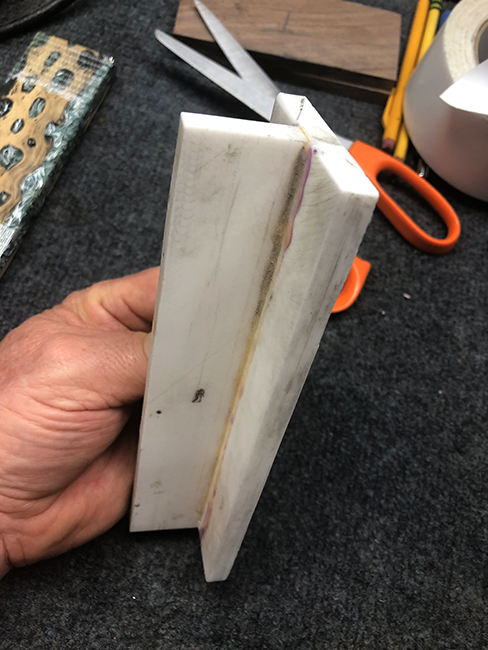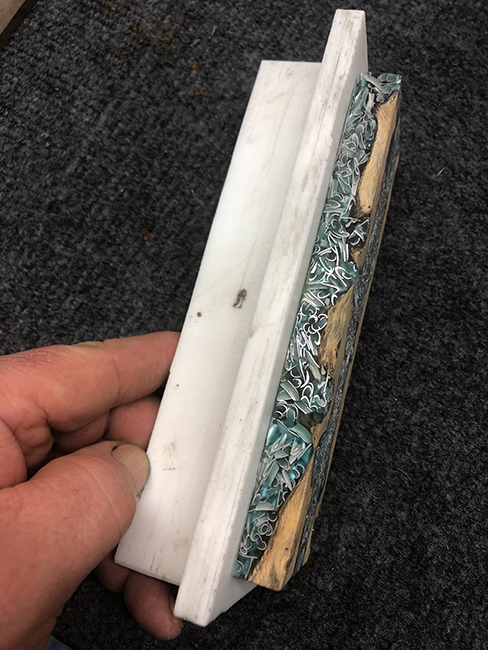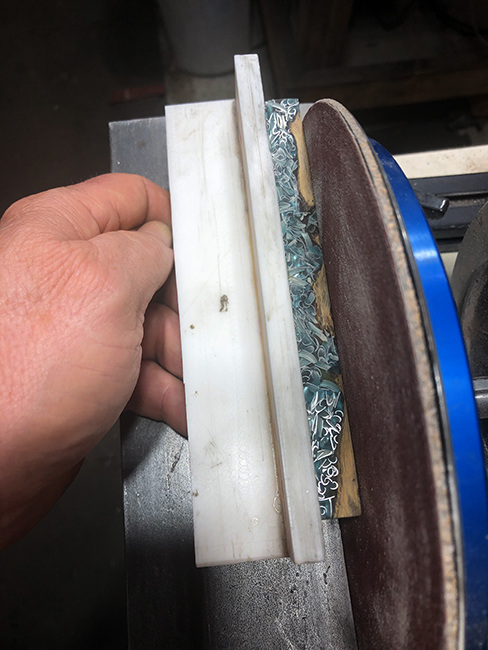- Joined
- Mar 26, 2018
- Messages
- 5,453
Hello Shop Talk,
I hope you are all doing great tonight! I have recently been cutting blocks into scales for knives and I am looking for a faster/easier way to get the thickness nice and even. I know there have been a few threads on this over the years, but it seems like there were just as many different answers to the question as there are threads, and it is hard to pick out the most definitive or easiest/most cost effective way. I am using a cheap Skil 9" band saw (with a homemade single-point fence) to cut the scales and the widest blade it accepts is 3/8" (I am currently using a 1/4” blade). I've gotten the band saw to track pretty darn straight, but I often end up with not only slightly wavey cuts, but even worse... Sometimes one end is 7/16" while the other is closer to 9/16" (likely due to skill). I have been using a combination of belt and disc sanders as well as sandpaper on a granite surface plate to get them even. It's not much fun to be frank and is pretty time consuming. I just ordered a 3/8" blade, but I don't expect that to make much difference. I also have a Milwaukee portable band saw and Swag Table for cutting steel. Maybe I would get better results with that with the 1/2” blade than the Skil if I were to pick up a fence for the Swag Table??
I would like to find a cost effective (under $200 would be great) way to quickly and easily get scales to an even thickness. I have probably a couple of hundred blocks on hands so the less brainpower/skill required the better, lol.
I thought about buying a table saw and a Grr-ripper push block, but I don't think it would get much use outside of making scales so I'm hesitant to spend $400 - $500 on one. I'm also not convinced that the cheaper Dewalt table saw would give me dead flat scales.
A buddy told me to pick up a table top planer, but I'm working with scales that are 1.5" x 5" x 3/8" and that seems risky because of tearout. I will also be cutting a lot of stabilized scales and feel like that's a bad idea.
Another option I thought of was to buy a drum sander, but again hesitant to spend $600 on a tool that will likely only be used for scales. It seems like that would give really good results though...
Which brings me to the StewMac Safe-T-Planer. Do any of you have experience with this, and/or do you think it would work for my purposes? I have a cheap Harbor Freight drill press that I would be using it with, but I'm not against upgrading the drill press since I want to pick up a mini mill eventually anyways. The head cuts a 2.75" wide path and seems like it would really speed things up. I'd still have to lap with sandpaper and the surface plate, but getting the scales equal is the time consuming and tedious part for me.
This video looks of it looks rather promising.
Any other ideas that would give me great results without too much effort for under $200?
Thanks!
I hope you are all doing great tonight! I have recently been cutting blocks into scales for knives and I am looking for a faster/easier way to get the thickness nice and even. I know there have been a few threads on this over the years, but it seems like there were just as many different answers to the question as there are threads, and it is hard to pick out the most definitive or easiest/most cost effective way. I am using a cheap Skil 9" band saw (with a homemade single-point fence) to cut the scales and the widest blade it accepts is 3/8" (I am currently using a 1/4” blade). I've gotten the band saw to track pretty darn straight, but I often end up with not only slightly wavey cuts, but even worse... Sometimes one end is 7/16" while the other is closer to 9/16" (likely due to skill). I have been using a combination of belt and disc sanders as well as sandpaper on a granite surface plate to get them even. It's not much fun to be frank and is pretty time consuming. I just ordered a 3/8" blade, but I don't expect that to make much difference. I also have a Milwaukee portable band saw and Swag Table for cutting steel. Maybe I would get better results with that with the 1/2” blade than the Skil if I were to pick up a fence for the Swag Table??
I would like to find a cost effective (under $200 would be great) way to quickly and easily get scales to an even thickness. I have probably a couple of hundred blocks on hands so the less brainpower/skill required the better, lol.
I thought about buying a table saw and a Grr-ripper push block, but I don't think it would get much use outside of making scales so I'm hesitant to spend $400 - $500 on one. I'm also not convinced that the cheaper Dewalt table saw would give me dead flat scales.
A buddy told me to pick up a table top planer, but I'm working with scales that are 1.5" x 5" x 3/8" and that seems risky because of tearout. I will also be cutting a lot of stabilized scales and feel like that's a bad idea.
Another option I thought of was to buy a drum sander, but again hesitant to spend $600 on a tool that will likely only be used for scales. It seems like that would give really good results though...
Which brings me to the StewMac Safe-T-Planer. Do any of you have experience with this, and/or do you think it would work for my purposes? I have a cheap Harbor Freight drill press that I would be using it with, but I'm not against upgrading the drill press since I want to pick up a mini mill eventually anyways. The head cuts a 2.75" wide path and seems like it would really speed things up. I'd still have to lap with sandpaper and the surface plate, but getting the scales equal is the time consuming and tedious part for me.
This video looks of it looks rather promising.
Any other ideas that would give me great results without too much effort for under $200?
Thanks!
Last edited:







